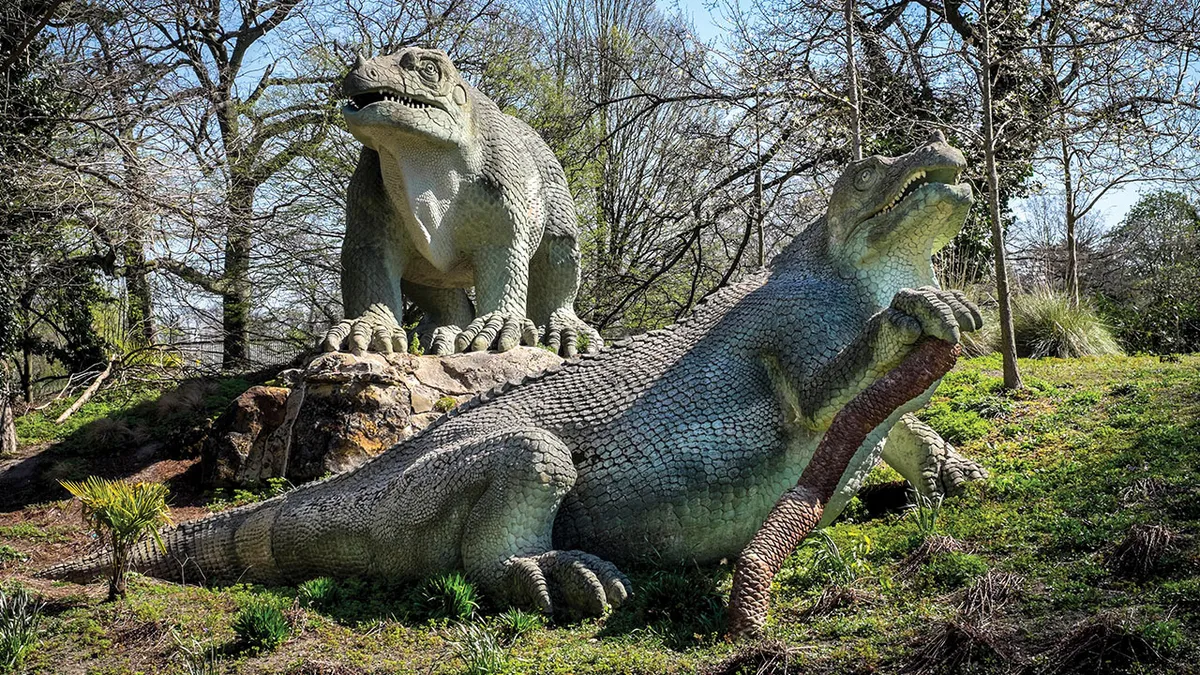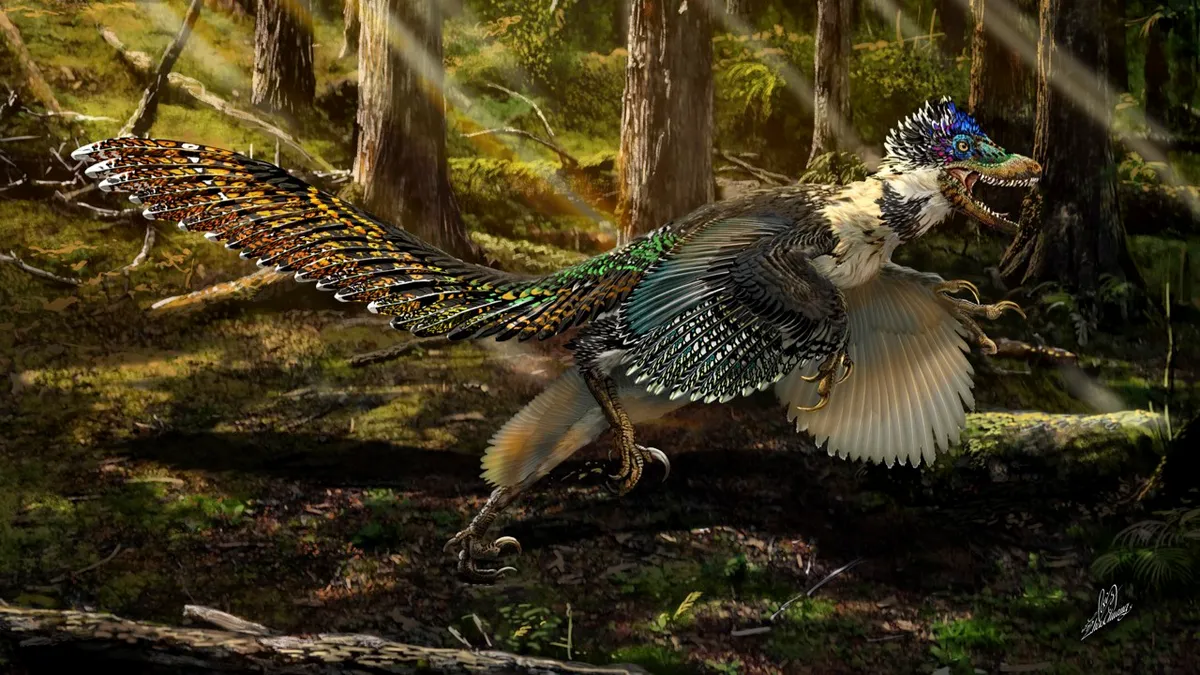Back in October 2015, a new dinosaur was revealed from the 66-million-year-old Hell Creek formation in South Dakota, USA. Colourful pictures of this swift, bipedal predator – covered in feathers and with a jaw full of sharp teeth – were published around the world.
Experts behind the discovery reported that Dakotaraptor had large, sickle-shaped claws on the second toes of its hind feet, and would have been about five metres long and slightly taller than a human. This made it one of the largest ever dromaeosaurs (‘swift seizers’), the group to which Velociraptor also belongs. We take these kinds of reconstructions for granted these days, but just how realistic are they, and how do we know what dinosaurs really looked like?
The first attempts by humans to imagine the animals that left fossils or footprints of themselves behind were in prehistory, and there are hints that dinosaur remains made it into many ancient mythologies. Dragons appeared in Chinese texts as far back as 1100BC, and may have been influenced by dinosaur bones. Similarly, griffins – beasts that combine an eagle with a lion – are known from Ancient Greece as early as 700BC; the inspiration may have come from fossils of the beaked dinosaur Protoceratops, remains of which are still found in the deserts of Central Asia today.
When ancient people were faced with strange bones, they did exactly what we do today, and used the best knowledge available to reconstruct the creatures that left them behind. Sometimes this resulted in poor conclusions. The first name assigned in print to any dinosaur remains was the ignominious title of Scrotum humanum – a label given by British physician Richard Brookes to the broken end of a femur in 1763, believing it to be the fossilised testicles of a Biblical giant.
We now know that the leg bone belonged to a Megalosaurus – correctly described as an extinct reptile by William Buckland in 1824. You can’t entirely blame Brookes for his conclusions, as dinosaurs would not be described as a group until 1842. That was when Richard Owen, head of what is now the Natural History Museum, revealed to the world a new class of strange, extinct creatures he called dinosaurs, meaning ‘fearfully great reptiles’. He imagined Iguanodon, Megalosaurus and Hylaeosaurus to be reptiles with legs sprawled out to the sides, with scaly grey or green skin: something like modern lizards or crocodiles.
In 1854 artist Benjamin Waterhouse Hawkins created life-sized sculptures of these animals as directed by Owen, and you can still see these on display in Crystal Palace Park in south London. Visit them and you will see they look very different to how we depict dinosaurs today.

Over time, we have come to completely revise our understanding of the appearance of dinosaurs, and much of this began with the description of another American dromaeosaur called Deinonychus in the 1960s. John Ostrom at Yale University made the revolutionary suggestion that this species was a bird-like, fast, warm-blooded pack hunter, and so began the ‘dinosaur renaissance’ of the 1960s and 70s. Ostrom championed the idea that birds were dinosaurs, and was spectacularly vindicated when Sinosauropteryx, the first known feathered dinosaur, was found in China in 1996.
First steps
When faced with new fossils today, palaeontologists have a much bigger body of knowledge to draw upon when creating reconstructions. In fact, our knowledge has increased to the degree that – somewhat miraculously – we can tell the colours of the dinosaur feathers of a range of species.
All dinosaur reconstructions begin with their fossilised bones. If palaeontologists are lucky enough to have found a fairly complete skeleton, they can arrange these bones into the appropriate order – based on how the bones of birds, crocodiles and even people are arranged – and start to get a sense of the shape of the creature.
Complete dinosaur skeletons are, however, very rare. The majority of fossil specimens have bones missing, and a great number of species are only known from a fraction of the original skeleton. In these cases, the bones of different specimens can be compared to fill in the gaps, and if there are parts of the skeletons that are still unaccounted for, experts will often look to related species of dinosaur for help with the reconstruction.
Detailed knowledge of the anatomy of a range of modern species (a field known as comparative anatomy) is helpful here, and many dinosaur experts are excellent anatomists. To those in the know, small details of the shape of bones can reveal a great deal of information about the animal they came from. For example, dinosaurs and birds (which are a kind of theropod dinosaur) are unique in having a hole in their pelvis called a ‘perforated acetabulum’ into which the top of the thigh bone (femur) fits on each side. This is a unique trait of dinosaurs, allowing them to stand erect with their legs underneath their bodies, rather than sprawling out to the sides as in other reptiles. The dinosaur hip also allows experts to identify between the two major branches of the dinosaur family – ornithischians and saurischians.
Theropods, the carnivorous group of saurischian dinosaurs to which T. rex, Allosaurus, and now Dakotaraptor belong, have a series of other tell-tale traits in the fossils. These include hollow bones full of air pockets, three fingers on the hands, and much reduced fourth and fifth digits on the feet.
Maniraptorans, the group of theropods from which birds evolved, have more distinct features, including an unusual wrist joint with a bone called a ‘semilunate carpal’. This gave these carnivores more flexible wrists – useful for seizing prey with their hands – and allowed the flight stroke of birds to evolve.
When you’re out on a dig with experts you realise that even small details, such as the shape of teeth or the curves of limb bones, are enough for experts to make rapid assessments about the specific types of dinosaur that they belonged to.
Beyond bones
Bones, however, are only the start of a dinosaur reconstruction. It’s also important to think about muscles. For example, discs of muscle between the vertebrae of a sauropod dinosaur such as Brachiosaurus or Diplodocus would have made a great difference to the overall length of the animal. Muscles are added by referencing the exact positions and shapes of muscles in living animals. Fossilised bones often have ‘muscle scars’ that show attachment points, which aid in this process. Since we know that larger, heavier modern animals have bigger marks, we know we need to add bigger muscles to those dinosaurs.
Our understanding of the finer details of dinosaur anatomy has altered over time, and continues to improve with 3D computer models that use the physiology of living animals to make predictions about extinct species. Sauropods, like Diplodocus, used to be depicted with their heads held high on their necks and their tails dropping down to the ground, but we now know this wouldn’t have been possible. Instead, we reconstruct them with their necks and tails in a more horizontal position, acting as counterbalances to each other. Palaeontologists are increasingly making use of digital, biomechanical models to test their ideas about how dinosaurs walked and used their jaws.
Finally, layers of fat and skin are added to our reconstructions, as well as scales, feathers, armour, crests and any other features such as cheeks, lips, claws and beaks. There are surprising pieces of evidence that come to bear on these decisions too. We have some truly incredible skin impressions for a range of dinosaurs – particularly herbivores like Edmontosaurus and Saurolophus.
The prevalence of scaly skin impressions in the fossils of herbivorous dinosaurs has led experts to believe that the majority had scales instead of feathers (although a handful of herbivorous dinosaurs have been found with bristles and other feather-related features).
We also know that some herbivores, particularly the armoured ankylosaurs, were covered in defensive bony plates, spikes and knobs. These bony growths in the skin, known as osteoderms, often fossilised and give a good sense of how animals like Scelidosaurus – discovered in Dorset in the 1850s – would have appeared in life.
In herbivorous dinosaurs there are other features that we can infer from the bones in the skull. Duck-billed hadrosaurs have large grinding teeth at the backs of their jaws, and it’s likely that these were covered with cheeks, allowing them to hold more food in their mouths for chewing before swallowing. In other dinosaurs, such as Protoceratops, Triceratops and Oviraptor, we can see the inner bony part of a beak that, in life, would likely have been covered with an outer keratinous layer as in birds today. Keratin is the same tough protein that feathers, hair, fur and fingernails are made of. Did dinosaurs have lips? This is something we still don’t know, and is an area of current debate.
Fluffy theropods
Carnivorous theropods, in contrast to the herbivores, were frequently covered in feathers. The incredible fossils of nearly 50 species – mostly from China’s northeastern province of Liaoning – show a range of feathery coverings, from downy, insulating ‘dino-fuzz’ to flashy display and flight feathers. Some of these animals are so exquisitely preserved that we can see the shape and arrangement of feathers right across their bodies.
Though most of these feathered dinosaurs have been found in China, the spread of species across the family tree suggests that most theropods in other parts of the world were feathered too – we just have a fantastic window into the past with Liaoning because of the type of preservation found in its volcanic deposits.
Sometimes we have other evidence of dinosaur feathers, such as marks on the forearm bones of Velociraptor which correlate to the ‘quill knobs’ where the ligaments of flight feathers attach on pigeons today. It’s this feature in Velociraptor fossils from Mongolia that led experts to assume all dromaeosaurs had small ‘wings’ on their forearms – a feature now confirmedby the Chinese fossil of another new dromaeosaur called Zhenyuanlong, described in 2015 by scientists including Dr Stephen Brusatte at the University of Edinburgh.

Quill knobs were also found in the Dakotaraptor fossil, and the scientists behind this discovery, led by Robert DePalma at the Palm Beach Museum of Natural History in Florida, estimated it to have had a wingspan of around a metre.
Artists also play an essential role in bringing dinosaurs to life, and often have expert anatomical and palaeontological knowledge to build on the scientific evidence with informed guesswork. Without these palaeoillustrators, such as Emily Willoughby who created the lovely feathery image of Dakotaraptor, the appearance of these animals would live only inside the minds of the scientists who discovered them.
In the last five years, the colours of dinosaur feathers have come into focus, but we may soon have a good idea of dinosaur skin colours too. We already know from the patterns of scales on some ‘mummified’ fossils that Edmontosaurus was probably adorned with stripy patterns, even if we’re not sure what colour they were, and a number of studies have started to use electron microscopes to look at the structural patterns of tiny packages of pigment in the skin.
In 2015, an international team of scientists used this technique to show that a prehistoric marine reptile called a mosasaur had a dark back and a pale-coloured belly, while another marine reptile – a dolphin-shaped ichthyosaur – had universally dark pigmentation. It won’t be long before similar methods are used to determine the colours of dinosaurs too.
Reconstructing animals from fossils is partly guesswork, but it’s informed guesswork, building on the knowledge built up over the centuries by pioneering palaeontologists. Today, we have a better idea of what dinosaurs looked like than ever before.
